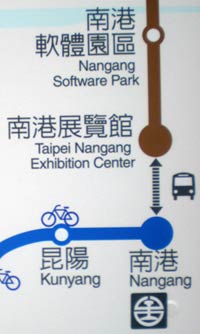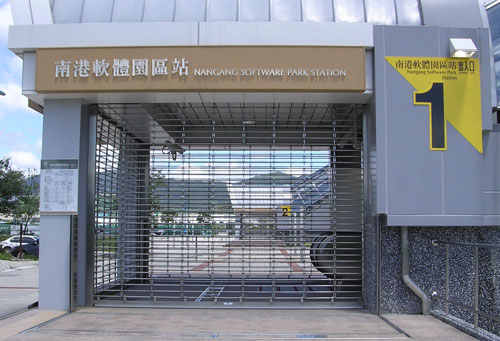 Taipei will soon open a dozen new stations on its mass-transit system, the MRT. Most of the stations will be in the relatively newly developed district of Neihu, with a couple in the Nangang district. It’s the latter two stations I want to focus on:
Taipei will soon open a dozen new stations on its mass-transit system, the MRT. Most of the stations will be in the relatively newly developed district of Neihu, with a couple in the Nangang district. It’s the latter two stations I want to focus on:
- Nangang Software Park
- Taipei Nangang Exhibition Center
Basically, these names suck.
The most obvious problem is that they both are unnecessarily long, which is not a negligible consideration for not only signage but also the MRT’s announcement system, which is in four languages: Mandarin, Hoklo, Hakka, and English. (It takes a while to get through all of those.)
Also, “Nangang Software Park” (Nángǎng Ruǎntǐ Yuánqū 南港軟體園區)? There is no other software park around the MRT system. Just “Software Park” would work better as a name for the station. Accurate, but also short, simple, and distinctive — just what such a name should be.
BTW, this software park is the source of the name for Taipei’s still-not-corrected Park Street signs.
Worse still is “Taipei Nangang Exhibition Center”. First, calling it even “Nangang Exhibition Center” would be bad enough for the same reason that “Nangang Software Park” is unnecessarily wordy: there’s no “exhibition center” anywhere else on the system.
But “Taipei Nangang”? Ugh. That may work in Mandarin, but it’s lousy English. It follows the same unnaturally inverted pattern and redundancy that gave us “Taiwan Taoyuan International Airport,” or, as I like to call it, Chinglish International Airport. (But I do like it better than “Revere the Dictator Chiang Kai-shek International Airport.”)
Here’s a photo of the exhibition building itself (not the MRT station — though those are the MRT tracks behind the barrier in the foreground).

So “Taipei Nangang Exhibition Center” probably is the official name of the complex. But that really doesn’t matter because (1) the MRT station certainly does not have to have the exact same name and (2) the name is just plain stupid.
Above, I mentioned that names for MRT stations should be “accurate, but also short, simple, and distinctive.” Sticking “Taipei Nangang” in front of “Exhibition Center” makes the name clumsy and less distinctive, especially since the two MRT stations closest to “Taipei Nangang Exhibition Center” are called “Nangang” and “Nangang Software Park”.
Nangang, Nangang, Nangang — yeah, we get it: They’re in Nangang.
Perhaps the MRT would like to change other names to be similarly useful. For example, instead of “Chiang Kai-shek Memorial Hall” we could have “Taipei Zhongzheng Chiang Kai-shek Memorial Hall;” and in place of, say, “Xindian City Hall” we could have “Taipei County Xindian Xindian City Hall.” (More about the Xindian City Hall station in another post.)
But perhaps those names aren’t nearly informative enough. According to the MRT’s way of thinking, people might still be confused about the location. How about, say, “Planet Earth Northern Hemisphere Asia East Asia Taiwan Taipei Zhongzheng Chiang Kai-shek Memorial Hall” and “Planet Earth Northern Hemisphere Asia East Asia Taiwan Taipei County Xindian Xindian City Hall,” etc.?
I’m happy to report that even the MRT seems to have some reservations about ridiculously long names — at least when those names are in Mandarin. Note the photo of part of the route map (top right of this post). The Mandarin name for “Taipei Nangang Exhibition Center” is Nángǎng Zhǎnlǎnguǎn (南港展覽館), not Táiběi Nángǎng Zhǎnlǎnguǎn (台北南港展覽館). (I didn’t crop any characters from the left of the station name.) So why is “Taipei” in the English version but not in the Mandarin one? Does the city government believe that foreigners are so stupid that they fail to comprehend that the Taipei MRT system is indeed in the Taipei metropolitan area? If so, then maybe they should be giving consideration to my idea of putting at least “Planet Earth Northern Hemisphere Asia East Asia Taiwan Taipei” in front of all the names in the city of Taipei. This could come in in several versions:
- “Planet Earth Northern Hemisphere Asia East Asia Taiwan, Republic of China, Taipei” — for pan-blue traditionalists
- “Planet Earth Northern Hemisphere Asia East Asia Taiwan, which is really a country and not a part of China, Taipei” — for the pan-green crowd, and
- “Planet Earth Northern Hemisphere Asia East Asia China Chinese Taipei Taipei” — for the unificationists and those who like to “q?n Zh?ngguó“
Then administrations could have fun changing from one system to another, depending on who was in power.
There’s more to say about this topic (e.g., how the names of stations such as Taipei Zoo, Taipei City Hall, and Xindian City Hall Office do or don’t fit into this pattern). But I’ve already written enough for one post.
And in case anyone is wondering: Yes, I have brought my concerns to the attention of the officials of the MRT. They don’t care. Does anyone have contacts in the media or with politicians?


:lol:
The one near my house is pretty good. ??? (Dazhi Station). I don’t believe there are any other Dazhis on the Taipei MRT system. But perhaps they will build another Dazhi one day. What will we do then?
:)
“But “Taipei Nangang”? Ugh. That may work in Mandarin, but it’s lousy English. It follows the same unnaturally inverted pattern”
“Taipei Nangang” doesn’t strike me as being lousy. Maybe that’s because I’m far more sensitive to the opposite problem you usually see in Chinese-to-English translation: translators who have been fed that stupid line about “Chinese go from most general to most specific; Westerners go from most specific to most general”, and thus take whatever sounds natural in Chinese and formulaically write it exactly backwards in English. E.g. “Zhongguo Shandongsheng” becoming “Province of Shandong of China” rather than the more natural-sounding “China’s Shandong Province”.
Lets not forget that there are also corresponding bus stops for all those stations. As far as I know, all MRT station names listed on Taipei city bus root maps start with jié yu?n (??) and end with zha?n (?). So, Táib?i Náng?ng Zh?nl?ngu?n (???????) would be written as Jié Yu?n Táib?i Náng?ng Zh?nl?ngu?n Zha?n (??????????)
to Peter, well, you’re wrong at nangang exhibition center bus stop, ’cause as the route map above, we don’t have Taipei(??)in chinese, so it would just be Jié Yu?n Náng?ng Zh?nl?ngu?n Zha?n (????????), it’s fine in chinese
Pingback: Weekly Links – June 18, 2009 « The Daily Bubble Tea
Excellent and hilarious post, already shared it ! :)
lol
There’s a bus stop on Heping btw Fuxing and Jianguo, named something like “National Taipei Education University Associated Vocational High School”. The English recording has to say it at something like double speed to get it all in.
Well on the other hand e.g., the name “Technology Building Station” (on
the Muzha line) makes Taiwan seem like one of those puny countries where
there will only ever be one technology building.
@Eric: It would be more likely to translate it as Shandong, China – returning to the specific->general formulation. There weren’t any possessives in the Chinese version so ‘China’s Shandong Province’ and ‘Province of Shandong of China’ are not accurate renditions – unless the ‘de’ is understood?
I’ve always wondered why the powers-that-be decided the station names had to be translated into English in the first place. Subway station names in Japan are almost always rendered in roman letters exactly the way they are read in Japanese – i.e. ?????? is “Kokkai-gijid?-mae”, and not “National Diet Building” (let alone the most literal translation, “In front of the National Diet Building”!).
Number of mentions of city name in station names of subway of same city (NMCNSNSSC):
Hong Kong station (but Hong Kong is also name of island it’s on)
Beijing Railway Station, Beijing Capital International Airport
Beijing South Railway Station, Beijing Zoo, Beijing West Railway Station
Taipei Main Station, Taipei City Hall, Taipei Zoo
Taipei Nangang Exhibition Center
But I wouldn’t be too critical. At least Taipei’s MRT is running smoothly: “rated most reliable for 4 years in a running”
As a Parisian, I can only look with envy on that number of incidents graph. Sure, Paris has good subway station names and an NMCNSNSSC of zero, but we can only dream of having as clean and reliable a subway as Taipei’s.
Pingback: Pinyin news » You can’t fight city hall, er, office
I hope no one tells the Taipei MRT people about this: Next London Subway Stop: Spiritual Enlightenment.
I have to disagree. Just because there is only one software park or exhibition center in the system now doesn’t mean there won’t be in the future. Following your suggestion, there would then be “Exhibition Center” and “Blah Exhibition Center” stations, and people would abbreviate the latter as just “Exhibition Center” (especially when they’re closer to it than the other), leading to much confusion.
That’s sort of the situation in Shanghai, with “Shanghai Railway Station” and “Shanghai South Railway Station” in opposite directions on the same line. The non-South station is more prominently signed because it used to be the end of the line, and I’m sure some people have ended up there when they meant to go to the other.
It’s better to have at least one non-generic word in each station name. (Although I agree there’s no need to put Taipei in the name of that one.)
It appears someone told TVBS, a popular TV news station, about this, as this post was cited in a story that just aired. (I didn’t see it myself.) Given how stories are rerun, it might air again sometime between 8:35 and 8:45 this evening.
Sorry, my clock stopped. Make that earlier.
I saw it. Very nice. :)
IT might be mentioned somewhere in here:
http://www.tvbs.com.tw/index/index.html
But I can’t spot it…
Here’s a link to a write-up: Nèihú jiéyùn y?u “f?nyì” jiàn — zhàn míng Y?ngyì w?ngy?u b?zhàn (????????????????). It’s not a very good article, though, and it features one of my least favorite approaches: ask a random foreigner what they think. That’s the sort of thing that stuck us with nicknumbering. But, still, I suppose it’s better than nothing. Anyway, if someone in the media wants to talk with me, I’m not hard to find.
This penchant for long names in Taiwan seems also extends into government branches, and the insistence of local writers to include the entire hierarchy of branches and sub-branches in the name of the office.
Example (I’m making part of it up, but doing so to illustrate the point):
* Office of Animal Cruelty Prevention, Bureau of Animal Affairs, Council of Agriculture, Executive Yuan, R.O.C.
Also, there are those interminable names of schools (this one is absolutely real):
* The Affiliated Senior High School of National Taiwan Normal University
The least they could have done was eliminate “The” and “Senior” (rolls eyes)